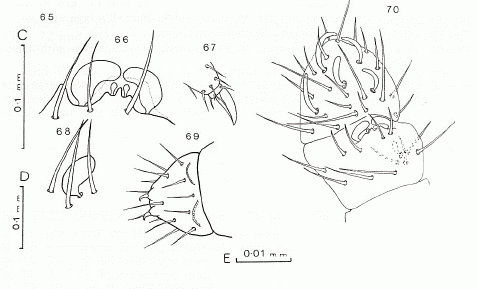Collembola form the largest of the three lineages of modern hexapods hat are no longer considered insects (the other two are the protura and diplura). Though the three orders are sometimes grouped together in a class called Entognatha because they have internal mouthparts, they do not appear to be more closely related to one another than they all are to insects, which have external mouthparts.
Members of Collembola are normally less than 6 millimeters (0.24 in) long, have six or fewer abdominal segments and possess a tubular appendage (the collophore or ventral tube) with eversible vesicles, projecting ventrally from the first abdominal segment. The Poduromorpha and Entomobriomorpha have an elongated body, while theSymphypleona have a globular body. Collembola lack a tracheal respiration system, which forces them to respire through a porous cuticle, to the notable exception of Sminthuridae which exhibit a rudimentary, although fully functional, tracheal system.
Most species have an abdominal, tail-like appendage, the furcula, that is folded beneath the body to be used for jumping when the animal is threatened. It is held under tension by a small structure called the retinaculum and when released, snaps against the substrate, flinging the springtail into the air. All of this takes place in as little as 18 milliseconds.
Sexual reproduction occurs through the clustered or scattered deposition of spermatophores by male adults. Stimulation of spermatophore deposition by female pheromones has been demonstrated in Sinella curviseta. Mating behaviour can be observed in Symphypleona Among Symphypleona, males of Sminthurididae use a clasping organ located on their antenna. Many collembolan species, mostly those living in deeper soil horizons, are parthenogenetic, which favours reproduction to the detriment of genetic diversity and thereby to population tolerance of environmental hazards. Parthenogenesis (also called thelytoky) is under the control of symbiotic bacteria of the genus Wolbachia, which live, reproduce and are carried in female reproductive organs and eggs of Collembola. Feminizing Wolbachia species are widespread in arthropods and nematodes, where they co-evolved with most of their lineages.
Species of Mesaphorura are very small (typically 0.7 mm in length) soil-dwelling Collembola.
Kingdom: Animals
Subkingdom:Eumetazoa
Phylum: Arthropoda
Subphylum: Hexapoda
Class: Entognatha
Order: Collembola
Suborder: Poduromorpha
Family: Tullbergiidae
Subfamily: Tullbergiinae
Genus: Mesaphorura
Species: krausbaueri
www.nzetc.org Zoology Publications from Victoria University of Wellington
Jermy Tibor és Balázs Klára (Szerk): A növényvédelmi állattan kézikönyve VI. Akadémiai Kiadó, Budapest, 1988.
http://www.stevehopkin.co.uk/collembolamaps/Poduromorpha/160MSkra/
